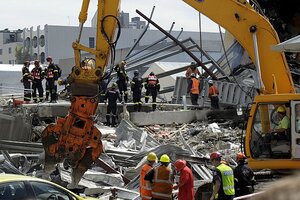New Zealand earthquake rescue efforts now in full swing
With the New Zealand earthquake death toll now at 98, authorities have mounted the country's largest-ever rescue operation in a bid to save as many of the 226 missing people as they can.

Recovery operation personnel worked Thursday on the destroyed CTV building in Christchurch, New Zealand. The city was hit by a 6.3 magnitude earthquake Tuesday.
Rob Griffith/AP
Wellington, New Zealand
Since Tuesday's 6.3 magnitude earthquake leveled New Zealand's second-largest city, Christchurch, officials have been scrambling to mount what has become the largest search-and-rescue operation in the South Pacific nation's 170-year history.
Other countries have been quick to pitch in, too.
The US was among the first nations to dispatch a team to help with building searches and structural inspections. The 75-strong American contingent has since been joined by more than 320 international rescue workers drawn from Australia, Britain, Japan, Singapore, and Taiwan, working alongside some 1,100 local army personnel.
Also fanning out on the rubble-strewn streets has been a self-declared "student army" – shovels and iPods at the ready – drawn from the two nearest major institutions of higher learning, Lincoln University and the University of Canterbury, both of which have been closed since Tuesday.
For all the activity, though, hundreds of buildings in the downtown remain unsearched. Instead, much of the effort has concentrated on 10 major buildings in the central business district, including the Pyne Gould Corporation structure and the iconic Christchurch Cathedral, which between them may account for 49 of the 226 police say are still missing.
So far, success stories are scant. Rescuers haven't been "getting a huge number of positive responses from the buildings where we would expect there to be more people trapped alive,” Prime Minister John Key told reporters in Wellington today. Still, recent rescue operations for more damaging earthquakes in Chile and Haiti proved that persistence pays. One teenage girl in Haiti, for instance, was saved after being trapped under rubble for 15 days.
CTV, a major local newscaster, might have been among the news sources that locals with access to power would have relied on to follow the work in
progress, but its centrally located namesake building was among others most badly hit. Up to 120 bodies are believed to still be inside.
An unknown number of students from Asia, mostly Japan, enrolled in a private English-language program housed in the same building, are also believed to be among the casualties.
